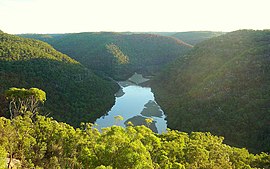Hornsby Plateau
Appearance
 The river valleys of the plateau | |
| Coordinates | 33°46′22″S 151°11′14″E / 33.77274°S 151.18726°E |
|---|---|
The Hornsby Plateau is a
Sydney Harbour that rises 200 metres. The plateau is a part of the larger Sydney Basin structure.[1]
Geography
The
lithosols, which has low fertility and is normally less than 500 mm deep.[4]
Geology

Rock deposits in the
siliceous clay. At the end of the Tertiary period, or about 80 million years ago, earth movements created an upheaval of 600 metres in most of coastal eastern Australia, due to the rifting and opening of the Tasman Sea. Thus, these movements created the Blue Mountains and Hornsby Plateaux, with the lagging behind of the peneplain becoming the Cumberland Plain.[5]
The plateau was scoured by
freshwater streams, which perforated a labyrinth of V-shaped valleys with intruding rocky ridges into the Hawkesbury Sandstone. The drainage activity is ascertained by the Hawkesbury Sandstone's impotence, which were employed by early watercourses. As the creeks carved deeper into the plateau, they began undercutting the sandstone walls of the valley, and as such, blocks of sandstone fell down, thus creating cliff lines.[6]
Due to its hilly topography, the plateau was slow to develop. It has two main sedimentary rock layers:
Hawkesbury sandstone, consisting mostly of sandstone, but with some shale, and the overlying Ashfield Shale, which supports richer vegetation. There are also a few volcanic intrusions
throughout the plateau.
See also
References
- ^ Sydney Basin-Subregions
- ^ Geology, topography and soils Friends of Berowra Valley
- ^ Geology of the Sydney Basin Sydney Vignerons Association Inc.
- ^ Chapman, G.A. & Murphy, C. L. 1989, Soil Landscapes of the Sydney 1:100 000 Sheet, Soil Conservation Service of NSW, Sydney.
- Office of Environment and Heritage (New South Wales)
- ^ Herbert, C. & Helby, R. (eds) 1980, A Guide to the Sydney Basin, Dept. of Mineral Resources, Geological Survey of NSW, bulletin no. 26.

